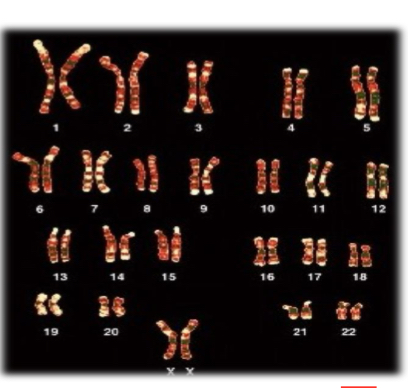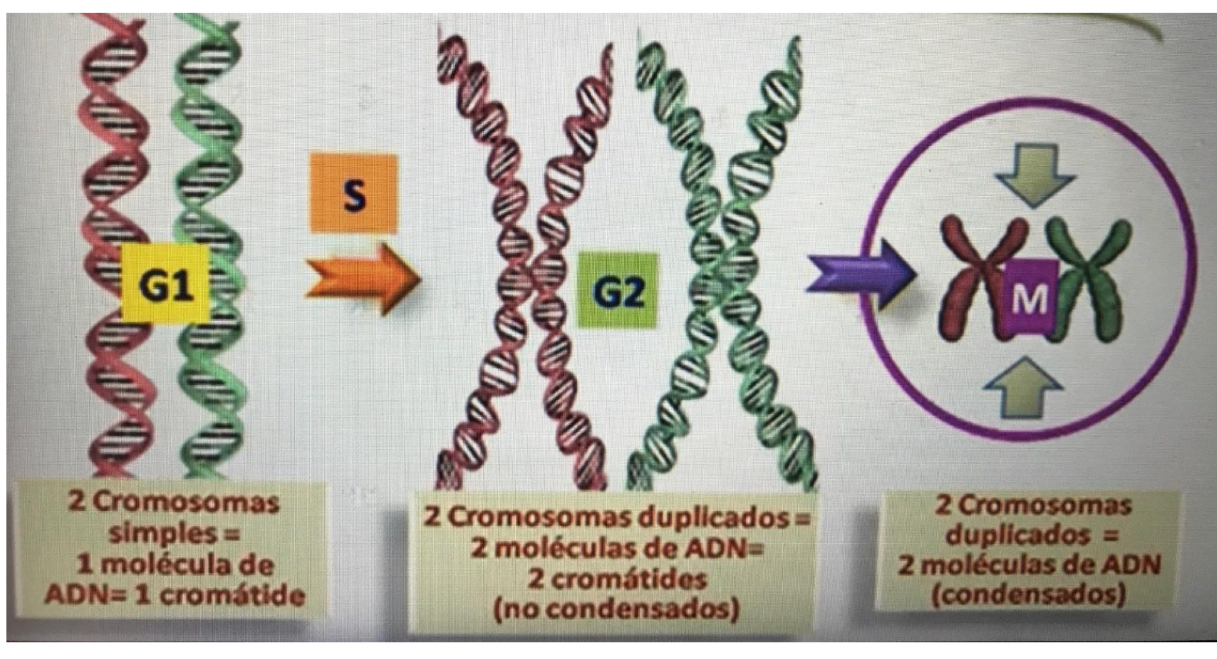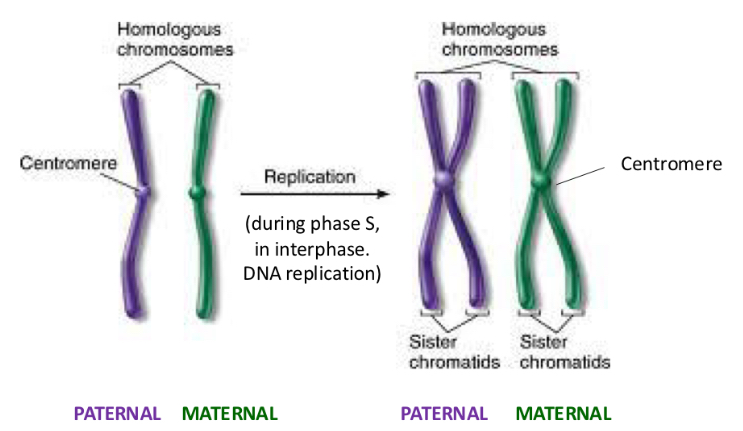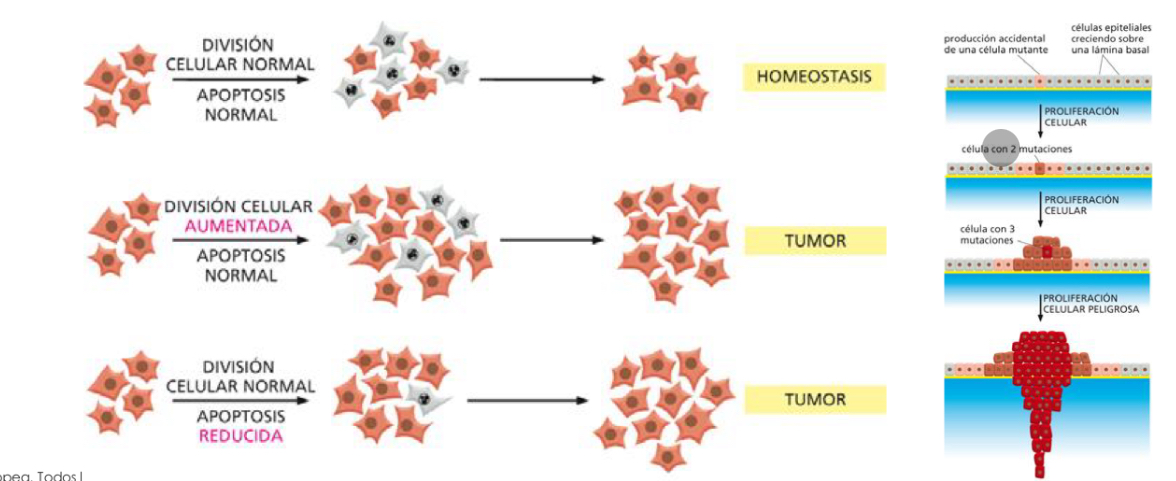Lesson 8: Cell cycle and regulation
1/28
There's no tags or description
Looks like no tags are added yet.
Name | Mastery | Learn | Test | Matching | Spaced |
|---|
No study sessions yet.
29 Terms
What is ploidia?
The number of complete sets of chromosomes in a cell.
Either haploid (1n) or diploid (2n)

What are homologous chromosomes and where do they come from in humans?
Pairs of chromosomes with identical morphology.
In humans, one comes from the father and one from the mother.

What is chromatid?
A condensed chromatin molecule (DNA molecule)
Compartments of a Chromosome
Consists of two chromatids (replicated DNA)
What are the 2 types of cells in humans?
Somatic and germ cells
Somatic cells
The cells that produce the growth of tissues and organs.
Contain 46 chromosomes organised into homologous chromosomes (they have two sets of chromosomes, they are diploid, 2n).
Every cell that is not a germ cell.
What is a germ cell?
From which gametes (eggs and sperm) are formed.
In higher organisms they have only one set of chromosomes,
they are haploid (n).
What are the 2 types of chromosomes in humans and how many are they?
22 pairs of somatic Chromosomes (autosomes)
1 pair of sex chromosomes

What are the types of reproduction?
Asexual reproduction and sexual reproduction
Asexual reproduction
Related to the mechanism of mitotic division, where two genetically identical individuals originate from one parent.
Sexual reproduction and the phenomena it is based to
mixing of genomes from 2 progenitor individuals through the fusion of
gametes, which generates genetic variability.
Sexual reproduction is based on two phenomena:
• Special division: meiosis halves the number of chromosomes
(2n → n)
• Cell fusion: fertilisation(n + n → 2n)

Cell renewal
Important for Homeostasis which requires that when cells die or are lost, they are replaced by tissue-specific cells.
rate at which some cells in the body are replaced is slow or absent (e.g. in the nervous or endocrine system),
while other cells are replaced very rapidly (e.g. epithelial or blood cells).
What is the cell cycle and which stages does it include?
sequence of events that lead to cell proliferation and cell division →
a progenitor cell gives rise to two daughter cells
Two stages of the cell cycle:
-Interphase: period of cell growth between two successive divisions
-M Phase: Period of division, which in turn is divided into:
→ Mitosis (M Phase): genetic material is divided
→ Cytokinesis: cell splits in two (cytoplasmic division)

What is the purpose of cell division
The genetic material and the cell mass are equally distributed among the two daughter cells.
Replication of S Phase
DNA molecules double their content
Chromosomes double their DNA content, the number of chromosomes does not double

Homologous chromosomes during S Phase
paternal and maternal copies of a specific chromosome of a diploid cell.

Result of the duplication of a chromosome
Sister chromatids separated in 2 daughter cells

What is the Interphase?
Phase between two cells divisions
Longest phase in cell cycle (95%)
Preparatory phase that includes cell growth and DNA synthesis

Stage of Interphase
G1: growth phase and phase of preparation for DNA synthesis
6-12 hours
- RNA and protein synthesis.
- Duplication of cellular structures and organelles.
- Cells that re nor dividing and are differentiating: G0 phase
- Restriction point, if passed, the cell continues to next phase
stage of Interphase
S: DNA replication - 6-8 hours
- Each of the 46 chromosomes is replicated to form a sister chromatid.
Stage of Interphase
G2: checkpoint control and preparation for cell division - 3-4 hours
-Protein and RNA synthesis
- safety interval (the cell ensures that all DNA has been synthesised before continuing celldivision).
- checkpoint (regulatory molecules assess nuclear integrity)
Which mechanisms control cell profilation and division?
1. Extracellular growth factors.
2. Intracellular enzyme regulation, by protein complexes. This is the most important mechanism of cell cycle regulation
Growth factors
• Growth factors are extracellular molecules that activate proto-oncogenes (genes involved in normal cell division).
• The cell depends on external stimuli from growth factors to progress through the cell cycle before reaching the point of restriction.
If these proto-oncogenes become altered (I.e.. mutation or amplification) produce oncogenes - involved in tumor development

Enzyme regulation
Cell cycle progression is controlled by regulatory proteins:
▪ Cyclins:
Their concentration rises and falls constantly throughout the cell cycle because they are constantly being synthesised and degraded
▪ Cyclin-dependent kinases (CDK).
Found in constant numbers during cells cycle, but their enzymatic activity is dependent to the cyclin concentration
Cyclins and cyclin-dependent kinases (CDK) form complexes
cyclin-CDK.

Checkpoints
Control the completion of critical event and if necessary delay progress to the next stage of cell cycle
G1 Checkpoint
Most important
Point of restriction, where it is decided wether the cell will divide or not
-intact DNA before cell growth to ensure proper cell growth
-cell must have adequate levels of nutrients, size and receive correct extracellular signals to start a ne division
G2 Checkpoint
DNA replication is complete
Repairing DNA replication errors
M Checkpoint
Correct stages of divison
Are all chromosomes properly aligned and attached to the mitotic spindle?
Consequences of errors in cell divison checkpoints
-contribute to Tumor developement and progression
-Tumour cells often acquire mutations and epigenetic changes that inactivate cell checkpoints, preventing cell death.
